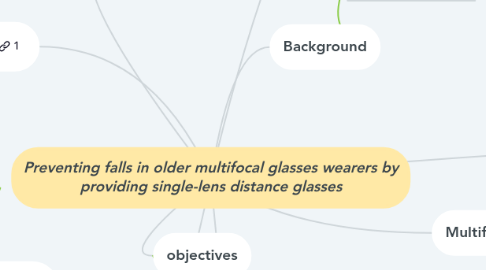Preventing falls in older multifocal glasses wearers by providing single-lens distance glasses
by zully serna

1. Determine if prescription of single-distance lenses are recommended to prevent falls in users of multifocal glasses
2. objectives
3. Method
4. 580 adults will participate
5. multifocal lens users
6. Participants will be assigned lenses from a unique lenses
7. the primary measurements will be the result of the first fall
8. the secondary measures will be with a follow-up of the quality of life and the physical activity
9. Study results
10. When using multifocal lenses, older people showed greater variability in the minimum vertical space of the foot when climbing
11. People wearing multifocal lenses were more likely to fall during follow-up
12. Users of multifocal glasses were more likely to fall when they were out of their homes, and when they went up or down stairs by 41%
13. Determine whether the provision of complementary single-lens distance lenses for elderly multifocal lens users, along with recommendations for use in outdoor and standing activities, can reduce fall rates over a 13-month period
14. The participants are chosen if they run a risk of falls from 65 to 79 years
15. Include : a user of bifocals, trifocals or with progressive lenses 3times / week when walking outdoors
16. For research, people will not be eligible if:
17. 1. have a cognitive disability 2. A serious visual impairment 3. Does not understand the English language for the evaluation 4. Have an unstable medical condition at the time of enrollment.
18. Compliance and adverse events.
19. Compliance will be measured each month according to the recommendations given by means of a questionnaire
20. The report of the type of lenses used is recorded
21. falls caused by any event other than the change of multifocal lenses will be recorded in fall schedules
22. Calculate the effect of the lenses on the health status, lifestyle and fear of users falling
23. Background
24. Refractive error
25. presbyopia
26. It occurs when the crystalline lens of the eye loses flexibility
27. Makes it difficult to focus on nearby objects
28. Correction is done with lenses that have far vision and near vision or multifocal lenses
29. Multifocal lenses
30. advantage
31. Useful for focal length changes
32. Tasks such as: driving, shopping and cooking
33. disadvantages
34. There is a blur of distant objects in the lower part of the lens
35. affect the perception of distant depth and contrast sensitivity
36. The negotiation of steps and the precision of the placement of the foot when treading a raised surface in elderly people
37. Initial evaluation
38. It will be explained to the people in which the research consists
39. Participants will be asked if they are sure they can use the lenses
40. They will be asked to sign a consent and an evaluation
41. All patient data and possible data that may alter the results as medical records will be recorded.
42. Monocular and binocular visual acuity will be evaluated
43. The risk of falls and functional mobility will be measured with the TUG test
44. Then the participants will enter the study and will be assigned to the control groups
45. Intervention
46. - The participants will have an objective refraction exam with the optometra
47. - They will prescribe unique lens distance lenses
48. The correction for the single lens glasses will be combined with the prescription of the upper segment of your multifocal glasses
49. - Four weeks later, the participants will receive their lenses
50. An optometrist will demonstrate how multifocal lenses can affect visual abilities by detecting obstacles and assessing depth,
51. Will do tests of contrast sensitivity and seeing stimuli in the upper and lower part of multifocal lenses
52. Images will be projected with distortion and without distortion of the lower visual field to increase the risk of falls with multifocal
53. It is used to prevent users from using multifoca
54. The optometrist will advise the participants to use single lens lenses for many activities at home and abroad
55. the use of multifocal lenses will be recommended for tasks where there is a minimum risk


